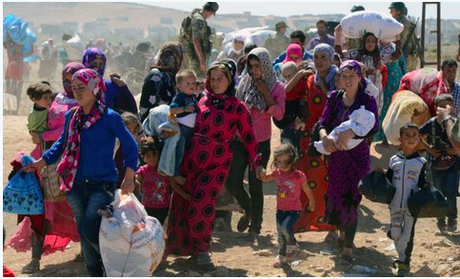Suggested Reading for Week Ending 9/28
The People’s Climate March on September 21 was a watershed for the emerging global climate movement, with more than 400,000 people taking to the streets of New York City. But New York was only the tip of an iceberg. People in 166 countries, from Argentina to Australia, participated in more than 2,800 events and rallies. Two million activists demanded through an online petition that governments shift to 100% clean energy.
Thousands of environmentalist and Occupy Wall Street activists gathered in Battery Park early Monday morning in the wake of Sunday’s mass demonstration. The group gathered to prepare for a civil disobedience action known as Flood Wall Street at Battery Park. Flood Wall Street organizers planned civil disobedience in their strategy to highlight a need to go against the financiers of climate change by changing business as usual on Wall Street.
Whether it’s the Middle East or Eastern Europe, the United States foreign policy is back under control of neoconservatives with the goal of regime change for our enemies or the enemies of Israel.
A student demonstrator, Tyrone G Parks, a senior at Arvada High School, said Tuesday that the nation’s foundation was built on civil protests, “and everything that we’ve done is what allowed us to be at this point today. And if you take that from us, you take away everything that America was built off of.”
There were alternatives. The U.S. and the international community could have contained and shrunk ISIS by cutting off its funds and its revenue from sale of oil on the black market. We could have looked to strike a deal with Syria and Iran.
This [Middle East] animosity has resulted in a new campaign in the west to demonize the Qataris as the key supporter of terrorism. The Israelis have chosen the direct approach of publicly accusing their new enemy in Doha of being terrorist supporters, while the UAE has opted for a more covert strategy: paying millions of dollars to a U.S. lobbying firm – composed of former high-ranking Treasury officials from both parties – to plant anti-Qatar stories with American journalists. That more subtle tactic has been remarkably successful, and shines important light on how easily political narratives in U.S. media discourse can be literally purchased.
Ira introduces Carmen Segarra, a bank examiner for the Federal Reserve in New York who, in 2012, started secretly recording as she and her colleagues went about regulating one of the most powerful financial institutions in the country. This was during a time when the New York Fed was trying to become a stronger regulator, so that it wouldn’t fail to miss another financial crisis like it did with the meltdown in 2008.
We seem to have forgotten about the Syrians we’re supposedly helping.

“… perhaps once we have freed ourselves, we can reach out to free the people of Gaza.”
